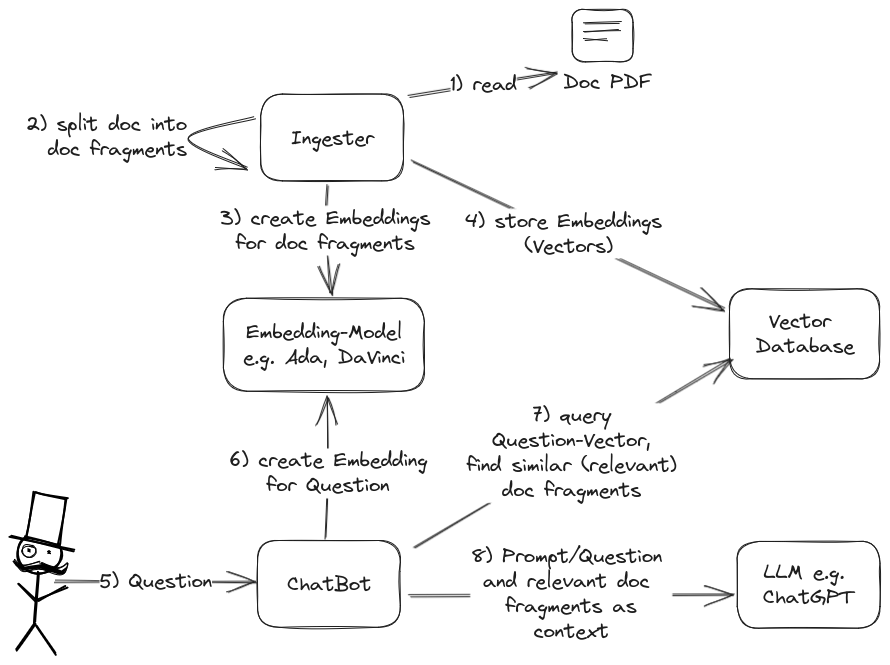
LangChain: the framework for building applications powered by large language models
Connect, integrate, and unleash the power of large language models and external sources without writing boilerplate code.

In a recent article we introduced LangChain , which is a powerful open-source framework for developing applications powered by language models (LLMs). In this article we will approach a more complex example and show you, how to build a chatbot that understands your documents.
The main problem we need to solve is that the language model is not aware of the content of our documents, so if we ask a question about our documents, the language model will not be able to give us a meaningful answer.
Addressing this problem entails developing a mechanism to integrate the content of our documents into the language model’s knowledge and reasoning processes. This integration should enable the model to effectively comprehend and utilize the document content, thereby empowering it to deliver pertinent, insightful, and contextually appropriate responses to queries associated with these documents.
Let’s look at some possible solutions.
We can simply pass the text of out document as context along with the prompt to the language model. This is the simplest solution of course, but it has some drawbacks:
If you consider these drawbacks acceptable, you could give this approach a try.
Fine-tuning the language model with a carefully curated dataset that includes your documents can yield remarkable performance improvements. This process tailors the model by creating a new version based on an existing one, enabling it to comprehend the specific domain and language utilized in your documents, resulting in more relevant and contextually appropriate responses. To equip a large language model for insightful and coherent conversations about your documents, it is imperative to address the challenges of fine-tuning, deploying, and operating the model effectively and efficiently.
In cases where you have a large dataset of documents, this approach can be very effective. However, it is important to note that this technique is very costly as it requires a lot of compute power and time to finetune a language model.
OpenAI also offers the possibility for finetuning their LLMs , which is a very interesting approach, if your document is not sensitive, and you can share it with OpenAI.
We will not go into detail here, but keep this in our backlog for a future article.
Let’s first look at the definition of Retrieval-Augmented Generation:
Retrieval-Augmented Generation is a sophisticated technique in natural language processing (NLP) that combines information retrieval and generative language models. It leverages a pre-existing dataset or knowledge base to retrieve relevant information, which is then integrated into the generation process. This approach enhances the quality and relevance of the generated text, enabling the model to produce more contextually accurate and informative responses. By seamlessly fusing retrieval and generation, it empowers NLP systems to excel in tasks such as question answering, content creation, and chatbots, where contextual understanding and factual accuracy are paramount.
In simple words: Retrieval-Augmented Generation is a method to generate better and more accurate sentences or answers by using a retrieval system, that gets relevant information (“semantic search”) and passes it to the language model, which then generates the final answer based on the prompt and the retrieved information. It’s an elegant way to make computer-generated text smarter and more useful without having to pass full documents and information to the language model.
With a powerful framework like LangChain at your disposal, building a chatbot using an existing LLM becomes a seamless process. By harnessing the provided abstractions for embeddings, storage and retrieval with vector databases and conversational chains, you can easily build a chatbot that understands your documents. The LangChain-implementations ensure that only pertinent context is provided to the LLM, effectively addressing our challenge of engaging in meaningful conversations about your documents.
Let’s see how this works in detail.
To be able to chat with our documents we need some preparation. We create an Ingester that reads our documents, splits them in reasonable chunks/fragments and creates embeddings for them. These embeddings are stored in a vector database. Later, when we chat about our documents and ask a question, we can create an embedding for our question and query the vector database for the most similar (= relevant) chunks of text from our documents. These chunks are then passed to the LLM as context along with the prompt. The LLM then has the question and (hopefully) enough relevant context to generate a meaningful response, which is then passed back to the delighted user.

Creating embeddings for chunks of text from our documents and storing them in a vector database for later lookup facilitates efficient and faster retrieval of relevant information during conversations. This approach helps us to access relevant fragments of your documents quickly and efficiently, which we then pass to the LLM resulting in more contextually appropriate responses.
But hold on, what are embeddings? Embeddings are a way to represent words, phrases, or even entire documents as numerical vectors in a multi-dimensional space. The OpenAI Embedding model “text-embedding-ada-002” for example creates vectors with 1536 dimensions. These vectors are designed in such a way that they capture meaningful relationships and similarities between the chunks of text they represent.
Imagine you have a dictionary, and you want to represent each word in that dictionary as a unique set of numbers. With good embeddings, words that are similar in meaning or context would have similar numerical representations, and words that are dissimilar would have dissimilar representations.
For example, in a well-designed word embedding space, the vectors for “king” and “queen” might be very close to each other because they are related in meaning and context, whereas the vector for “king” would be far from the vector for “apple” because they are unrelated.

These numerical representations are extremely useful in various natural language processing tasks like machine translation, sentiment analysis, and document similarity, as they allow computers to understand and work with textual data in a more structured and meaningful way.
We utilize embeddings and the similarity-retrieval mechanisms of vector databases for our chatbot to perform semantic search. This allows us to identify relevant pieces of information pertaining to the current question more effectively.
This approach is no silver bullet and there are some challenges we need to address: the token limit is still a thing, even if we pass smaller chunks of text (i.e. 1000 characters) to the LLM. We have to plan the size and the number of the fragments, so that everything fits into the token limit, which also comprises chat history and the question itself.
LangChain implements several strategies to address this problem in its DocumentChains :
Using this solution is a smart way to be able to “chat with your docs” and address the token limit and the cost problem. With the help of LangChain it is also rather easy to implement.
Let’s write some code.
To implement the chat with the documents with RAG, we need a handful of components:
We use the powerful LangChain abstractions, which already provide us with access to the required components and make our implementation much easier and more concise. To facilitate the implementation of a UI in the next blog article, we wrap the functionality into a class that provides appropriate methods for the chat.
We decided to use OpenAI for Embeddings and Chat and Chroma for the vector database. LangChain contains implementations for a variety of LLMs and vector databases, so you can choose the one that fits your needs best.
The ConversationalRetrievalChain
does the main work for us: it is based on the RetrievalQAChain
which takes care of the retrieval and the generation of the answer and adds the possibility to
provide the chat history of the conversation. We just need to provide the LLM, the embedding-provider
and the vector database.
We implement the class in a file called docchat.py:
import os
import sys
import openai
from langchain.text_splitter import RecursiveCharacterTextSplitter
from langchain.chains import ConversationalRetrievalChain
from langchain.document_loaders import PyPDFLoader
# LLM and embeddings
from langchain.chat_models import ChatOpenAI
from langchain.embeddings.openai import OpenAIEmbeddings
# Alternative LLM and embeddings: GPT4All
# from langchain.llms import GPT4All
# from langchain.embeddings import GPT4AllEmbeddings
# VectorDatabase - store & retrieve embeddings
from langchain.vectorstores import Chroma
# Alternative if you only have small docs: DocArrayInMemorySearch instead of Chroma, see DocChat._load_and_process_document
# from langchain.vectorstores import DocArrayInMemorySearch
openai.api_key = os.environ['OPENAI_API_KEY']
llm_name = "gpt-3.5-turbo"
# Use OpenAI for chat completion
llm = ChatOpenAI(model_name=llm_name, temperature=0)
# Use OpenAI to create embeddings for chunks and questions
embeddings = OpenAIEmbeddings()
# Alternative GPT4All, model must point to the model-file you want to use
# llm = GPT4All(model="/home/alex/.local/share/nomic.ai/GPT4All/wizardlm-13b-v1.1-superhot-8k.ggmlv3.q4_0.bin", n_threads=8)
# embeddings = GPT4AllEmbeddings()
# create Vector Database to insert/query Embeddings - we currently do not persist the embeddings on disk
vectordb = Chroma(embedding_function=embeddings)
class Document:
"""
Document class to store document name and filepath
"""
def __init__(self, name: str, filepath: str):
self.name = name
self.filepath = filepath
class ChatResponse:
"""
ChatResponse class to store the response from the chatbot.
"""
answer: str = None
db_question: str = None
db_source_chunks: list = None
def __init__(self, answer: str, db_question: str = None, db_source_chunks: list = None):
self.answer = answer
self.db_question = db_question
self.db_source_chunks = db_source_chunks
def __str__(self) -> str:
return f"{self.db_question}: {self.answer} with {self.db_source_chunks}"
class DocChat:
"""
DocChat class to store the info for the current document and provide methods for chat.
"""
_qa: ConversationalRetrievalChain = None
# string list of chat history
_chat_history: list[(str, str)] = []
# Holds current document, we can chat about
doc: Document = None
def process_doc(self, doc: Document) -> int:
"""
Process the document (split, create & store embeddings) and create the chatbot qa-chain.
:param doc:
:return: number of embeddings created
"""
self.doc = doc
(self._qa, embeddings_count) = self._load_and_process_document(doc.filepath, chain_type="stuff", k=3)
# Clear chat-history, so prompts and responses for previous documents are not considered as context
self.clear_history()
return embeddings_count
@staticmethod
def _load_and_process_document(file: str, chain_type: str, k: int) -> (ConversationalRetrievalChain, int):
loader = PyPDFLoader(file)
documents = loader.load()
# Split document in chunks of 1000 chars with 150 chars overlap - adjust to your needs
text_splitter = RecursiveCharacterTextSplitter(chunk_size=1000, chunk_overlap=150)
docs = text_splitter.split_documents(documents)
# Make sure that we forget the embeddings of previous documents
db = Chroma()
db.delete_collection()
# Fill Vector Database with embeddings for current document
db = Chroma.from_documents(docs, embeddings)
# Alternative: see https://python.langchain.com/docs/integrations/vectorstores/docarray_in_memory
# db = DocArrayInMemorySearch.from_documents(docs, embeddings)
# Create Retriever, return `k` most similar chunks for each question
retriever = db.as_retriever(search_type="similarity", search_kwargs={"k": k})
# create a chatbot chain, conversation-memory is managed externally
qa = ConversationalRetrievalChain.from_llm(
llm=llm,
chain_type=chain_type,
retriever=retriever,
return_source_documents=True,
return_generated_question=True,
verbose=True,
)
return qa, len(docs)
def get_response(self, query) -> ChatResponse:
if not query:
return ChatResponse(answer="Please enter a question")
if not self._qa:
return ChatResponse(answer="Please upload a document first")
# Let LLM generate the response and store it in the chat-history
result = self._qa({"question": query, "chat_history": self._chat_history})
answer = result["answer"]
self._chat_history.extend([(query, answer)])
return ChatResponse(answer, result["generated_question"], result["source_documents"])
def clear_history(self):
self._chat_history = []
return
# main method for testing only - please note: embeddings are not persisted
if __name__ == "__main__":
if len(sys.argv) != 3:
print("Usage: python docchat.py <file_path> <question>")
sys.exit(1)
file_path = sys.argv[1]
question = sys.argv[2]
doc_chat = DocChat()
file_name = os.path.basename(file_path)
embeddings_count = doc_chat.process_doc(Document(name=file_name, filepath=file_path))
print(f"Created {embeddings_count} embeddings")
response = doc_chat.get_response(question)
print(response.answer)
sources = [x.metadata for x in response.db_source_chunks]
print(sorted(sources, key=lambda s: s['page']))
In the last few lines, we implemented a main method to test our DocChat. We create a DocChat instance and process the document we want to chat about. Then we ask two questions and just print the answers.
Depending on the PDF you choose, you will get different answers, but the answers should be meaningful and contextually appropriate.
We use pipenv
for the management of virtual env and dependency management, you can easily install
it with pip install pipenv. We specify the requirements in a Pipfile and use pipenv install
to create a virtual environment and install the dependencies in one step.
This would be our Pipfile with the dependencies:
[[source]]
url = "https://pypi.org/simple"
verify_ssl = true
name = "pypi"
[packages]
langchain = {version = "==v0.0.308", extras = ["llms"]}
chromadb = "~=0.4.13"
pypdf = "~=3.16.2"
tiktoken = "~=0.5.1"
unstructured = "~=0.10.19"
# If you want to try GPT4All, see below
# gpt4all = "==1.0.12"
[requires]
python_version = "3.10"
To run our class, we need to install the requirements and set the OpenAI API key. Then we are ready to run our code.
As an example, I’ve obtained the transcript of Andrew NG’s CS229 Machine Learning Course in PDF format and saved it in a “/docs” folder in the current directory. However, feel free to use any PDF of your choice, provided that it contains text and does not consist of images only.
# Install Dependencies
pipenv install
You can launch a subshell with the virtual environment with pipenv shell and
run your python interpreter in this shell:
export OPENAI_API_KEY=<YOUR_API_KEY>
# start subshell in venv
pipenv shell
# |-- place path to your doc here --| |-- your question --|
python docchat.py "docs/MachineLearning-Lecture01.pdf" "What is CS229 all about?"
Alternatively you can use pipenv run to execute your python interpreter in
the virtual environment:
export OPENAI_API_KEY=<YOUR_API_KEY>
# |-- place path to your doc here --| |-- your question --|
pipenv run python docchat.py "docs/MachineLearning-Lecture01.pdf" "What is CS229 all about?"
Either way, the output should read like this:
CS229 is a machine learning class taught by Andrew Ng. It covers the technical content of machine learning,
including math and equations. The class assumes that students have a basic understanding of linear algebra
and matrix operations. Homework assignments and solutions are posted online, and there is a newsgroup for
class discussions. The class is televised and can be watched at home.
Please be aware the embeddings for your document are not persisted to disk. Therefore, each time you restart the application, you’ll need to recreate them, which may incur costs based on the document’s size and the number of segments it’s split into. The possibility to use our class via commandline is solely for a quick test of our base class for our chatbot - we will build a web-ui using this class in our next article. Depending on your use-case, it’s advisable to save and reuse the embeddings for efficiency and cost optimization. You can easily implement this functionality depending on your needs - you can store all documents in one single vector database and build a chatbot that can chat about all of them. Or you decide to store the embeddings for each document in a separate collection within one vector database or even in a separate vector database, so that you can control the scope of your chat.
As we have mentioned in our previous post about GPT4All
, we can use GPT4All models locally
to create embeddings and make use of powerful LLMs. We can use the same code as above, by just
installing the gpt4all package and altering a few lines (thanks to the LangChain abstractions)!
# -- comment lines using OpenAI
# llm = ChatOpenAI(model_name=llm_name, temperature=0)
# embeddings = OpenAIEmbeddings()
# ++ uncomment lines using GPT4All
from langchain.llms import GPT4All
from langchain.embeddings import GPT4AllEmbeddings
# you have to download a model and provide the path (here: Ubuntu, model downloaded with GPT4All Chat App - instead
# you can manually download Models at https://gpt4all.io/, scroll down to "Model Explorer")
llm = GPT4All(model="/home/alex/.local/share/nomic.ai/GPT4All/wizardlm-13b-v1.1-superhot-8k.ggmlv3.q4_0.bin", n_threads=8)
# the embedding model will be downloaded automatically
embeddings = GPT4AllEmbeddings()
Please note that GPT4All 1.0.9 seems to have a bug
, so you either have to stick to gpt4all = "==1.0.8"
or update to gpt4all = "==1.0.12" in your Pipfile.
If the performance of the GPT4All completion models does not suffice for your use case, you can mix and match and use OpenAI’s completion model and GPT4All for the Embeddings, effectively combining the strengths of both approaches.
In this article we built the foundation for a chatbot that understands your documents using Retrieval-Augmented Generation (RAG). We used the powerful LangChain-Abstractions to implement the base class for the chatbot in just a few lines.
In the next article we will explain how to build a simple but functional UI for our chatbot, so stay tuned!

Connect, integrate, and unleash the power of large language models and external sources without writing boilerplate code.

What impact will AI have on the work of agile teams in software development? Will we be supplemented by tools or will Agent Smith take over? In the following article, we strive to get an overview of current developments and trends in AI and how agent-based workflows could change the way we work.